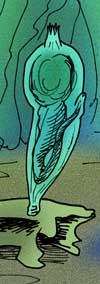Phlogites
| Phlogites Temporal range:
| |
|---|---|

| |
| Reconstruction of Phlogites | |
| Scientific classification | |
| Domain: | Eukaryota |
| Kingdom: | Animalia |
| Superphylum: | Deuterostomia |
| Stem group: | Ambulacraria |
| Clade: | †Cambroernida |
| Genus: | †Phlogites Luo & Hu, 1999 |
| Species: | †P. longus
|
| Binomial name | |
| †Phlogites longus Luo & Hu, 1999
| |
| Synonyms | |
| |
Phlogites, a senior synonym of Cheungkongella ancestralis,[1] (sometimes misspelt Cheungkungella)[2] is a cambroernid, and thus a member of the deuterostome total group. It is known from the Lower Cambrian Haikou Chengjiang deposits of China, and was initially compared to the tunicates.[3] It was originally described as a tunicate, though, this identification has been questioned, especially with the discovery of another Chengjiang tunicate, Shankouclava. It has most recently been interpreted as a cambroernid related to Eldonia, Rotadiscus and Herpetogaster.[4][5]
References[edit]
- ^ Hou, Xian-Guang; Bergström, Jan; Ma, Xiao-Ya; Jie, Z (2006). "The Lower Cambrian Phlogites Luo & Hu Re-Considered". GFF. 128: 47–51.
- ^ "The earliest history of the deuterostomes: the importance of the Chengjiang Fossil-Lagerstätte". Proc Biol Sci. doi:10.1098/rspb.2009.0646. PMC 2842668.
- ^ Shu, X. L.; Chen, D. G.; Han, X. -L.; Zhang, X. -L. (24 May 2001). "An Early Cambrian tunicate from China". Nature. 411 (6836): 472–473. doi:10.1038/35078069. PMID 11373678.
- ^ Caron & Conway Morris 2010, Plos one
- ^ Li et al. 2023, Current Biology
